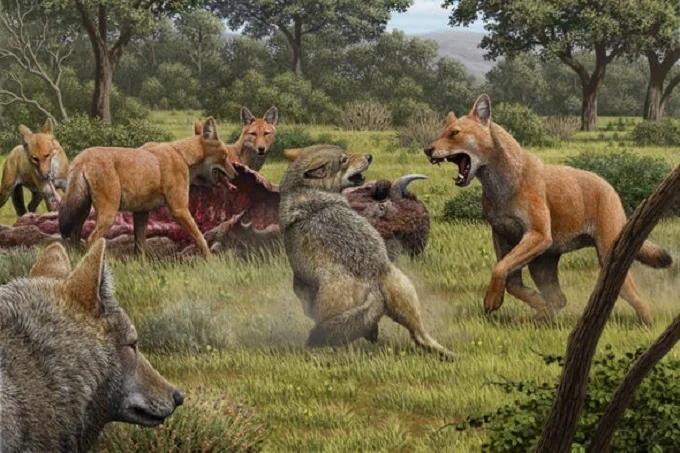The term “Dire Wolf” refers to a really extinct species of animal that existed during the Pleistocene epoch, Canis Dirus. Scientists haven’t been able to figure out why this species became extinct or what stopped it from developing until now.
Dire wolves (Canis Dirus) were formerly widespread throughout North America but became extinct about 13,000 years ago. Until today, scientists didn’t know much about their evolution. The new study, on the other hand, has given insight into the species’ past.
The ancient DNA of the bones of over 4,000 wolves discovered in the tar pits of La Brea, California, has been sequenced by scientists from the University of Durham.
Dire wolves’ DNA examination revealed that they are so unlike other species, such as coyotes and gray wolves (Canis lupus), that they could not interbreed with them, severely limiting their gene pool.
The findings also revealed that Dire wolves diverged from other members of the genus about six million years ago, indicating that they are only distant cousins of today’s species. Scientists originally thought the extinct species was closely linked to gray wolves, but ancient DNA sequencing has revealed dire wolves’ complicated evolutionary history.
“Dire wolves are commonly depicted as mystical and mysterious animals (e.g., in Game of Thrones), but the truth is more intriguing,” said Dr. Kiren Mitchell, one of the study’s primary authors.
How big were dire wolves
Dire Wolves are among the most well-known Pleistocene animals because of the massive number of bones discovered in the Rancho La Brea Tar Pits in California, where over 200,000 specimens have been discovered.
Dire wolves were far bigger than their contemporary counterparts, weighing between 60 and 68 kg (130-150 lbs) on average, compared to 45 kg (100 lbs) for Gray wolves, 30 kg (65 lbs) for Red wolves, and 14 kg (30 lbs) for Coyotes. Dire wolves possessed more meat-eating specializations in their teeth than contemporary wolves, and their leg proportions were gigantic, according to David Polly of Indiana University.
Dire wolves’ usual meal was probably between 100 and 299 kg (220-660 lbs), which is about equivalent to a big pig to a medium-sized moose. They would have supplemented their diet with smaller creatures like the extinct peccaries with whom they are often seen in the fossil record, while they would have taken much bigger prey. Their hunting habits and social structure were most likely similar to those of current wolves.
The Dire Wolf is famous in Indiana; Francis Lincke discovered the first fossil remains in the Ohio River terraces in Evansville in 1854. Lincke’s Indiana specimens were subsequently used by Joseph Leidy of the Philadelphia Academy of Sciences to characterize the species.
Canis Dirus has been found in at least three locations in Indiana, including the Evansville site and another in Monroe and Crawford Counties. It is known from all neighboring states except Michigan.
Dire wolf size compared to Lion
Dire wolves are extinct on Earth, but they must have weighed 150-200 pounds based on fossils unearthed. They weren’t very large, but they were well-built. The average weight of a Lion is 380 pounds. You’ll also encounter some gigantic lions. Angola once had a lion that weighed about 700 pounds. The lion was much larger.
